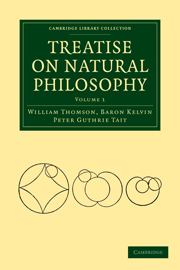CHAPTER I - KINEMATICS
Published online by Cambridge University Press: 07 September 2010
Summary
1. There are many properties of motion, displacement, and deformation, which may be considered altogether independently of such physical ideas as force, mass, elasticity, temperature, magnetism, electricity. The preliminary consideration of such properties in the abstract is of very great use for Natural Philosophy, and we devote to it, accordingly, the whole of this our first chapter; which will form, as it were, the Geometry of our subject, embracing what can be observed or concluded with regard to actual motions, as long as the cause is not sought.
2. In this category we shall take up first the free motion of a point, then the motion of a point attached to an inextensible cord, then the motions and displacements of rigid systems–and finally, the deformations of surfaces and of solid or fluid bodies. Incidentally, we shall be led to introduce a good deal of elementary geometrical matter connected with the curvature of lines and surfaces.
Motion of a point
3. When a point moves from one position to another it must evidently describe a continuous line, which may be curved or straight, or even made up of portions of curved and straight lines meeting each other at any angles. If the motion be that of a material particle, however, there cannot generally be any such abrupt changes of direction, since (as we shall afterwards see) this would imply the action of an infinite force, except in the case in which the velocity becomes zero at the angle.
- Type
- Chapter
- Information
- Treatise on Natural Philosophy , pp. 1 - 218Publisher: Cambridge University PressPrint publication year: 2009First published in: 1883

